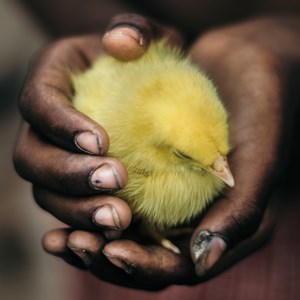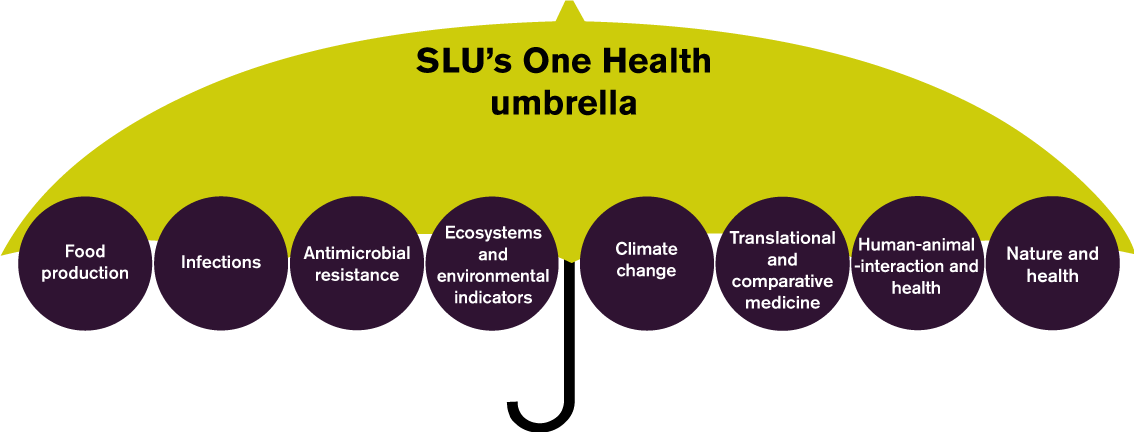One Health research at SLU

One Health research focus on the interaction between animal health, human health and ecosystem health. SLU produces knowledge to limit the spread of disease and antimicrobial resistance while securing sustainable food systems and use of natural resources. This interdisciplinary approach to the concept of health is called One Health.
One Health is an interdisciplinary research area and research within One Health is conducted at the SLU’s faculties: Landscape Architecture, Garden and Plant Production Science, Natural Resources and Agricultural Sciences, Forest Science, Veterinary Medicine and Animal Science. Here we present a selection of SLU’s wide range of activities within the field of One Health.

One Health research at SLU can be divided into eight categories.
Read more about different research areas under the menus below.
Food production
Safe food is an important aspect of this field where SLU have extensive knowledge on how food-borne infectious agents are spread.
Modern food production is a complex process, it is essential that sustainable and climate friendly cultivation and production systems are developed. This will enable us to produce safe food for humans and feed for animals while ensuring that the production of milk and meat is based on sustainable use of resources. Good animal health is a prerequisite for long-term sustainable animal husbandry. Healthy animals yield higher profits and don’t need medicines such as antibiotics.
It is also important to use environmentally-friendly alternatives for combatting plant diseases in order to ensure sustainable food production in the future.
Infections
"SLU has extensive experience in monitoring and conducting research on several central wildlife populations and their zoonoses. This creates excellent conditions for increasing our knowledge on how climate and landscape change affects the transmission and outbreaks of zoonoses".
– Associate Professor Frauke Ecke
SLU can contribute with valuable knowledge on how infectious diseases affect animals and humans. Some infectious agents are also zoonoses, i.e. diseases that can be transmitted between animals and humans. Outbreaks of infectious diseases cause suffering for animals and can also lead to major economic losses because of reduced production.
Production loss is a threat to global food supplies, particularly in those parts of the world where there is a lack of high-quality animal protein.
Antimicrobial resistance
One of the biggest threats in the future is loss of effectiveness among medicines against infectious diseases.
SLU plays an important role in the development of sustainable systems for good animal health and profitable animal production alongside a restrictive use of antimicrobial drugs. Antibiotic resistance is a threat to both animal and human health because bacterial infections are becoming increasingly difficult to treat.
We are striving to detect new anti-microbial substances in microorganisms that could be developed into new antibiotics.
– Professor Anders Broberg
Some of the projects conducted by researchers at SLU aim to find new future antibiotics in fungal and bacterial cultures and develop antibacterial fabrics and coatings to promote the healing of wounds. Just like bacteria, parasites have also developed resistance to medicines, which is also problematic for animal health.
In addition, SLU is conducting a number of research and development projects to produce vaccines to prevent and counteract different infectious diseases.
Ecosystems and environmental indicators
"Securing the supply of water now and for future generations is one of society’s greatest challenges and in order to succeed, we need to take a holistic approach that integrates knowledge from environmental research, veterinary medicine and infection biology".
- Professor Stefan Bertilsson
It is important to find safe alternative sources of protein, for example insects, in order to secure the production of food and animal feed in the future. It is also important to find ways of developing sustainable cycles, for example, the biodegradation of waste, to reduce levels of pathogenic microorganisms and pharmaceutical residues.
We need to take a holistic approach to the sustainable use of natural resources, humans as consumers and entrepreneurs, and sustainable food consumption. It is important to know how to increase the use of plant nutrients and reduce leakage in cultivation systems as well as animal husbandry.
We also need strategies to preserve and restore biological diversity in areas that are dominated by human activity. To a large extent, pets share the same indoor environment as humans which means they can be used as environmental indicators to study the effects of chemicals. For example, cats have been used as an environmental indicator for exposure to chemicals in indoor dust and for the occurrence of endocrine disrupting effects on the thyroid.
Climate change
Climate change is having a significant impact on human and animal health and implies an acute global health problem.
At SLU researchers are working on various projects to find sustainable solutions to reduce emissions of mmonia and greenhouse gases from livestock housing. This includes projects investigating whether emissions of methane from dairy cows can be reduced by substituting some of the concentrate feed with oats.
Climate change and warmer water may drastically change the size, structure and dynamics of fish populations, possibly increasing the number of fish in some populations but reducing numbers in others. This could be crucial for understanding the limits for how much fishing a certain population can withstand.
Translational and comparative medicine
Translational research can be described as when a problem that has been identified clinically, for example, diabetes, is used as the basis for pre-clinical research and development in veterinary medicine in order to better understand and treat or prevent disease in both humans and animals.
Researchers at SLU use animals as a model for humans in order to understand diseases such as cardiovascular disease, obesity, osteoarthritis, diabetes and cancer. Pets such as dogs or cats are good models since they live in the same environment as their owners and are exposed to the same lifestyle.
The clinical knowledge we gain when dogs and cats come for cancer treatment could also improve life for humans.
– Professor Henrik Rönnberg
The interaction between microbiota and gastrointestinal health is another subject in translational medicine. Here, the aim is to identify useful microbes and microbe-coded functions in the bowel in order to improve the gastrointestinal health of animals.
Human-Animal Interactions
The interaction between humans and animals is positive for the welfare and wellbeing of both parties.
International research has shown that both pets and livestock have a positive effect on health and can reduce healthcare costs. Pets and livestock are used in different ways and for different purposes for both leisure activities and animal-supported care measures.
At SLU, research is performed in the field of anthrozoology, which concerns the interaction between humans and animals. Among other things, animal-assisted interventions that can reduce stress and contribute to increased well-being for elderly in retirement homes are studied, as well as how horse-assisted activities can affect everyday life, quality of life and health in the neurologically ill.
SLU researchers also study how the relationship between pet owners and their pets, such as cats, dogs and horses, affects the well-being of both humans and animals, and which values of cats and dogs owners think are most important, and how these values relate to human health. An important aspect is, for example, the animals’ positive impact on the physical health of humans, through exercise and outdoor activities. Animal welfare is important in One Health and SLU researchers participate in developing international guidelines to ensure animal welfare and increase human safety in human-animal interactions.
Read more about the interaction between animals and nature for human health on our theme page. There you can find research projects, publications and other SLU researchers within the field.
Nature experiences and health
Contact with nature promotes both physical and mental health, by offering physical exercise, relaxation, and reduced stress.
Research at SLU includes interaction between different natural environments and human health. For example the impact of “just being” in nature, without the need for activity, is studied in relation to recovery from exhaustion syndrome, depression and traumatic experiences. Our researchers also study how nature and gardening can be used as a tool for rehabilitation and work training.
The urban outdoor environment, its form, function, and significance for health, quality of life and well-being, is investigated from different perspectives. Among other things, the effect of peri-urban forests on people’s opportunities for everyday exercise is studied.
SLU also runs a center, together with the Swedish Environmental Protection Agency, with the objective of developing opportunities for positive nature experiences and to help people find their way out into nature.
Read more about nature experiences and human health on our theme page. There you can find research projects, publications and other SLU researchers within the field.
Links
Meet One Health researchers at SLU.
Watch the film where we try to explain the One Health concept and how everything is connected.
Download our folder about One Health: